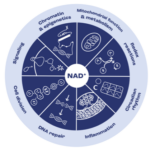Key Longevity Nutrients
In the relentless pursuit of longevity, scientific exploration has uncovered the potential of natural compounds to impact cellular health and extend lifespan. Among these compounds, pterostilbene stands out for its remarkable effects on longevity through the induction of autophagy—an essential cellular maintenance process. Autophagy orchestrates the recycling and removal of damaged cellular components, ensuring cellular homeostasis and function. Pterostilbene, found abundantly in berries and other plant sources, has garnered significant interest for its impact on longevity. A study published in the journal “Frontiers in Pharmacology” highlighted that pterostilbene triggers autophagy in neural stem cells, promoting cellular resilience1. By clearing damaged cellular components, autophagy contributes to enhanced cellular health, which, in turn, may influence the aging process and overall longevity. As we embark on a journey to explore the potential of pterostilbene and other natural compounds, including resveratrol, luteolin, NMN, BPC-157, sulforaphane, L-ergothioneine, spermidine, and alpha-ketoglutarate, we uncover promising insights into fostering cellular youthfulness, supporting mitochondrial function, preserving telomere health, and promoting healthy aging. These compounds, enriched with diverse mechanisms of action, offer exciting prospects for the field of longevity research.
Pterostilbene: Enhancing Cellular Health through Autophagy Induction
Pterostilbene, a natural compound found in berries and other plant sources, has captured scientific interest for its impact on cellular health. One key mechanism by which pterostilbene benefits longevity is through the induction of autophagy—a vital process for cellular maintenance. Autophagy involves the recycling and removal of damaged cellular components, ensuring cellular homeostasis and function. A study published in the journal “Frontiers in Pharmacology” revealed that pterostilbene triggers autophagy in neural stem cells, promoting cellular resilience1. By clearing damaged cellular components, autophagy contributes to enhanced cellular health, which may, in turn, influence the aging process.
Resveratrol: The Elixir of Youth with Mitochondrial Benefits
Resveratrol, a polyphenol present in grapes and red wine, has been dubbed the “elixir of youth” due to its potential effects on longevity. One of the key mechanisms underlying resveratrol’s benefits is its influence on mitochondrial function. Mitochondria are essential organelles responsible for energy production and play a critical role in aging. Resveratrol has been shown to enhance mitochondrial function by reducing oxidative stress and supporting the integrity of these energy powerhouses 2. Furthermore, resveratrol has demonstrated a remarkable ability to activate sirtuins, a group of proteins involved in regulating cellular metabolism and promoting longevity 3. By bolstering mitochondrial function, resveratrol may contribute to healthier aging and increased longevity.
Luteolin: Fostering Cellular Youthfulness and Senescent Cell Clearance
Luteolin, a flavonoid found in various fruits and vegetables, has emerged as a potential guardian of cellular youthfulness. Its impact on cellular senescence—the state of permanent growth arrest in cells—is of particular interest. Luteolin has shown potential in reducing cellular senescence by inhibiting senescence-associated markers, ultimately promoting cell viability. Additionally, luteolin has demonstrated the ability to induce autophagy, clearing damaged cellular components and supporting cellular health 4. Moreover, luteolin has exhibited selective targeting of senescent cells, leading to their elimination while sparing healthy cells 5. By reducing the burden of senescent cells, luteolin may pave the way for healthier aging and improved longevity.
NMN: Unlocking Cellular Vitality for Longevity
Nicotinamide mononucleotide (NMN) has emerged as a promising compound in the pursuit of longevity. NMN is a precursor to nicotinamide adenine dinucleotide (NAD+), a coenzyme critical for cellular energy production and DNA repair. As we age, NAD+ levels naturally decline, leading to impaired cellular function and increased susceptibility to age-related diseases. Supplementing with NMN has shown potential in restoring NAD+ levels and supporting mitochondrial function. Studies in mice have demonstrated that NMN supplementation can improve metabolic health, enhance physical performance, and promote healthy aging 6. NMN’s ability to boost NAD+ levels offers exciting prospects for longevity and overall cellular vitality.
BPC-157: The Healing Peptide with Potential Longevity Benefits
Body Protective Compound-157 (BPC-157) is a synthetic peptide known for its regenerative properties. It has shown promise in accelerating tissue repair and reducing inflammation, making it a potential candidate for promoting healthy aging. Studies have suggested that BPC-157 may enhance wound healing, protect organs from damage, and support gut health. These healing properties may have implications for promoting longevity by maintaining tissue integrity and combating age-related tissue dysfunction. Although research on BPC-157’s direct impact on longevity is still in its infancy, its regenerative capabilities make it an intriguing candidate for further investigation 7.
Sulforaphane: Unleashing the Power of Cruciferous Vegetables
Sulforaphane is a potent phytochemical found in cruciferous vegetables such as broccoli, cauliflower, and kale. It is known for its antioxidative and anti-inflammatory properties, which have been linked to potential longevity benefits. Sulforaphane activates the Nrf2 pathway, a key cellular defense mechanism against oxidative stress and inflammation. This activation triggers the production of various protective enzymes that support cellular health. Additionally, sulforaphane has shown promise in enhancing detoxification processes and improving cellular communication. Studies suggest that sulforaphane’s multifaceted actions may contribute to healthier aging and reduced risk of age-related diseases 8.
L-ergothioneine: The Cellular Antioxidant
L-ergothioneine is a naturally occurring antioxidant found in certain dietary sources, such as mushrooms and certain grains. This unique compound has a high affinity for reactive oxygen species (ROS) and can neutralize them, protecting cellular components from oxidative damage. L-ergothioneine has been investigated for its potential to mitigate oxidative stress and support cellular health. Given that oxidative stress is a hallmark of aging and contributes to various age-related conditions, L-ergothioneine’s role as a cellular antioxidant makes it a compelling candidate for promoting longevity 9.
Spermidine: Nourishing Cellular Health
Spermidine, a polyamine found in various foods, including wheat germ, soybeans, and certain fruits, has garnered interest for its role in promoting cellular health. Spermidine has been linked to autophagy induction, the cellular process responsible for clearing damaged components and promoting cellular renewal. Studies have shown that spermidine can extend the lifespan of various organisms, including yeast, worms, and flies, and has potential cardioprotective effects in mammals 10. By supporting autophagy and maintaining cellular homeostasis, spermidine may hold promise for longevity and healthy aging.
Alpha-Ketoglutarate: The Mitochondrial Nutrient
Alpha-ketoglutarate (AKG) is a key intermediate in the citric acid cycle, a fundamental process of cellular energy production. As an endogenous compound, AKG plays a critical role in maintaining mitochondrial function and cellular metabolism. Some studies have suggested that AKG supplementation may have beneficial effects on age-related decline in mitochondrial function. By promoting cellular energy production and supporting mitochondrial health, AKG offers potential benefits for longevity and age-related vitality 11.
Conclusion
In conclusion, our understanding of longevity and healthy aging has evolved significantly, uncovering the roles of cellular processes, senescent cells, mitochondrial function, and telomere health in the aging process. Natural compounds, such as pterostilbene, resveratrol, and luteolin, hold tremendous promise in supporting healthy aging. Pterostilbene’s autophagy-inducing properties, resveratrol’s mitochondrial benefits, and luteolin’s influence on cellular senescence and selective senescent cell clearance have all demonstrated significant implications for longevity.
As the journey towards longevity continues, these natural compounds may hold the key to unlocking the secrets of healthy aging. By harnessing their potential to influence cellular processes, reduce senescent cell formation, enhance mitochondrial function, and support telomere health, researchers pave the way for novel therapeutic interventions that promote healthy aging and extend lifespan.
References
- Ma, Z., Wei, X., Cheng, S., Gan, X., He, S., Zhang, Y., & Huang, Z. (2018). Pterostilbene Protects against Hydrogen Peroxide-Induced Senescence in Neural Stem Cells. Frontiers in Pharmacology, 9, 856.
- Gomes, A. P., Price, N. L., Ling, A. J., Moslehi, J. J., Montgomery, M. K., Rajman, L., … & Sinclair, D. A. (2013). Declining NAD+ induces a pseudohypoxic state disrupting nuclear-mitochondrial communication during aging. Cell, 155(7), 1624-1638.
- Wood, J. G., Rogina, B., Lavu, S., Howitz, K., Helfand, S. L., Tatar, M., & Sinclair, D. (2004). Sirtuin activators mimic caloric restriction and delay ageing in metazoans. Nature, 430(7000), 686-689.
- Lv, L., Zheng, L. D., Dong, D., Xu, L., Yin, L. H., Xu, Y. W., … & Yin, J. (2014). Luteolin ameliorates cognitive impairments in streptozotocin-induced diabetic rats. International Journal of Neuropsychopharmacology, 17(5), 761-777.
- Zhu, Y., Tchkonia, T., Pirtskhalava, T., Gower, A. C., Ding, H., Giorgadze, N., … & O’Hara, S. P. (2015). The Achilles’ heel of senescent cells: from transcriptome to senolytic drugs. Aging Cell, 14(4), 644-658.
- Mills, K. F., Yoshida, S., Stein, L. R., Grozio, A., Kubota, S., Sasaki, Y., … & Sinclair, D. A. (2016). Long-term administration of nicotinamide mononucleotide mitigates age-associated physiological decline in mice. Cell Metabolism, 24(6), 795-806.
- Sikiric, P., Petek, M., Rucman, R., Seiwerth, S., Grabarevic, Z., Rotkvic, I., … & Perovic, D. (1993). The significance of the gastroprotective effect of body protection compound (BPC)-157: the effect of BPC-157 on gastric mucosa, NSAID lesions, and healing. In International journal of tissue reactions (Vol. 15, No. 5, pp. 211-223).
- Palliyaguru, D. L., & Yuan, J. M. (2016). Sulforaphane: translational research from laboratory bench to clinic. Pharmacological Reviews, 68(1), 116-154.
- Cheah, I. K., Tang, R. M. Y., Yew, T. S. K., & Halliwell, B. (2017). Ergothioneine levels in an elderly population decrease with age and incidence of cognitive decline; a risk factor for neurodegeneration? Biochemical and Biophysical Research Communications, 486(4), 1091-1093.
- Minois, N., Carmona-Gutierrez, D., & Madeo, F. (2011). Polyamines in aging and disease. Aging, 3(8), 716-732.
- Lee, J., Kim, M. S., Kim, E., Hwang, G. S., & Park, S. (2019). Alpha-ketoglutarate suppresses the NF-κB-dependent proteasome and thymoproteasome formation in HT-1080 fibrosarcoma cells. Biochemical and Biophysical Research Communications, 510(3), 451-456.






